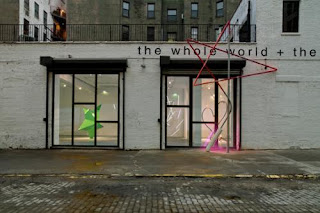



BERLIN'S BOROS COLLECTION
By R. Jay Magill, Jr. in Berlin
At first it stood as a defense against Allied bombs. In the 1950s it was used to store imported fruit from Cuba, and in the 1990s it became the location for the hottest techno-parties around. On Thursday an old Berlin bunker revealed its latest transformation: It now houses a private collection of contemporary art.
Walking through the massive five-storey concrete bunker that houses the Boros Collection on Reinhardstrasse in Berlin, you wouldn't guess that it had a far more sinister past. Back in 1942 Nazi architect Albert Speer built the place to help the city sustain what he believed would be the final blowout battle leading to a German victory. It was part of his and Adolf Hitler's grand "Germania" vision, whereby Berlin would be entirely renewed -- fully devoid of degenerate art, of course after the Germans had triumphed.
But today the old pock-marked fortress belongs to Polish-born collector and advertising entrepreneur Christian Boros and his wife Karen. And it was here on Thursday that they unveiled their impressive art collection that they've amassed over nearly two decades. Now the spiciest of international contemporary art sits in a cavernous piece of Berlin's architectural past. "This building is a landmark, a part of German history," Boros says. "It's not the Brandenburg Gate, but it has seen Berlin change a lot over the last half century."
After the end of World War II the bunker ended up in the Soviet sector of the city and the Russian army used it as a prison for captured German soldiers. Then, as something resembling normalcy returned to Berlin, the building was used to store bananas, oranges, and other fruits imported from Cuba by East Germany. After the fall of the Wall, East Berlin became the center of the city's party scene and "The Bunker," or "Banana Bunker," was the hottest place for wild techno raves and gay sadomasochism parties in Germany. The last one was held in 1996. Since then, the bunker has stood empty.
The 3,000-square-meter interior space, which once sheltered 2,000 people from flying bombs, now holds 80 contemporary works by artists such as Damien Hirst, Olafur Eliasson, Elizabeth Payton, Wolfgang Tillmans, Anselm Reyle, and Tobias Rehberger, all spread over five floors. While there are several series of photographs, most of the works on display reveal a fascination with sculpture: a giant copper bell by Kris Martin that precariously swings over the lobby; an Olafur Eliasson swinging fan that threatens onlookers with its pendular gyrations; a fluorescent-yellow, black-lit wooden cart sitting in a dark room; bales of silver-painted hay, and, perhaps most eerily, an hyperrealist rubber sculpture of a middle-aged man lying in a hospital bed, dressed in baby blue pyjamas, hands wrapped in gauze, staring lifelessly at the heavy concrete ceiling. "I collect art that I don't understand," Boros says.
The entire building 38 meters (125 feet) long and 16 meters (52 feet) high, with two-meter-thick concrete-and-rebar walls was particularly difficult to restructure. But starting in 2004 the architects Jens Casper, Petra Petersson, and Andrew Strickland from the Berlin-based firm Realarchitektur managed to make it happen. "We had to talk a lot about what we would do here," Casper says, "A lot."
They sat down with Boros and rethought the entire internal structure before removing 40 of the 120 rooms. Now some of them thrust 13 meters upwards over several stories, freeing up the otherwise cramped quarters originally all of the rooms were just 2.3 meters high. And where there were no windows, there is now a wall of them in the back stairwell. While there is no daylight in the exhibition space, the architects put the windows across from an exposed, ripped-up concrete-and-rebar wall so visitors can see just how reinforced a bunker really is. The project has been such a success the firm was recently awarded the 2008 Beton Architectural Prize for its work on the building.
Most impressive perhaps is the 1,000-square-meter penthouse that sits atop the old bunker, covered by a hulking 3-meter-thick concrete-and-steel roof. Surrounded in glass and leading out onto a sprawling tree-covered terrace, it's where the couple live, overlooking the middle of Berlin, sitting on top of their art. Standing on the sidewalk outside after leading journalists through his fortress, Boros was approached by an elderly man. "Does someone live up on top of this old thing?" he asked the mild-mannered collector. "I think someone does," Boros said. "I've heard it's nice."
The public can see for itself soon enough if that's true at least the part of the bunker that contains the impressive art collection. Starting at the beginning of June, it will be possible to request an appointment to visit on Saturday mornings through the Boros Collection Web site. "You have to remember that this is a private collection, not a museum," Boros says. "It's an incredibly subjective endeavour. It's something very much a part of our lives. Art, like history, is something to be talked about."





























